Poaching and Illegal trade of spotted deer in Sundarbans
Sundarbans, the world’s largest mangrove forest, has recently turned into a sanctuary for deer poachers. A significant number of media reported on the poaching of spotted deers at different parts of the Sundarbans.
Consequently, forest division and law enforcement groups have arrested around 63 professional poachers and recovered a significant number of hunting trap made of snares, venison, deer heads and deer hides in separate drives.
Village resident, poachers, shikaris, trappers and pirates are involved most in such illegal poaching of deer.
Sundarbans provides livelihoods for three to five million people from the southwest coastal belt of Bangladesh. It is also the home to the Royal Bengal Tiger; however, illegal poaching and wildlife trade are the top factors that affect the biodiversity of Sundarbans.
Unanimously, a gang of over 30 jungle pirates are active in wildlife killing and illegal fee collection from local forest resource of Sundarbans.
To protect biodiversity, the forest department is the steward of wildlife and natural resources of the Sundarbans. However, the team has limited survival resources, minimal logistical support, and security to conduct their work. Despite these challenges, one of the priority interventions is to advance patrol-monitoring systems in the Sundarbans.
Moreover, wildlife trading of hides and skins, teeth and other bones, venison is taking place. However, such activities are illegal and are necessary to stop the trading of wildlife products.
Climate change has already caused numerous shifts in biodiversity and changes the livings of the local people. Besides, the rising sea levels, frequent cyclones, and the increasing salinity in the water and soil have a severe impact on the livelihoods of the coastal people.
This study will try to find how local people are influencing the wildlife trade. Why are they making them involved in this illegal trade?
Objectives of this study
- To review the published articles on the poaching and illegal trade of wildlife in Sundarbans.
- To prioritise the issues discussed in those reports.
- To prepare an own datasheet to trace the severity of the poaching and illegal trade.
- To review the existing laws to protect the poaching and illegal trading of the wildlife.
- To find the key reasons why the poaching and illegal trade of wildlife is taking place.
Poaching is a high-priority threat to the spotted deer in the region, but studies have explored deer-killing behaviour in villages and the link between the trade of venisons and deer killing. There has been no research on the range of people involved, their motives and methods, and their relations to the commercial trade.
We aim to establish who is killing spotted deers, why and how, to design more effective conservation interventions that complement existing law-enforcement efforts.
This study is rare in the literature on deer conservation but provides essential baseline information upon which an effective strategy likely to implement for deer protection.
About Zulker Naeen
Zulker Naeen covers stories of climate change-induced food insecurity, natural calamities, and migration. As a citizen of one of the most climate-vulnerable nations, Zulker focuses his work on climate change. He works with the Climate Tracker to report climate resiliency for vulnerable women and access to climate finance.
Zulker involves in the Climate Tracker South Asia network, which improves the environmental consciousness of youth.
Naeen is also one of the Bangladeshi to win the South Asia Fellowship under Climate Tracker, is a global media network that closely works on Climate Change.
Zulker is also a Train the Trainer certified journalist who can design any climate change journalism course.
Zulker Naeen has developed courses with the support of other Climate Tracker staff. As a young climate advocate, his fellowship aims to share knowledge of climate change.




Comments
Post a Comment